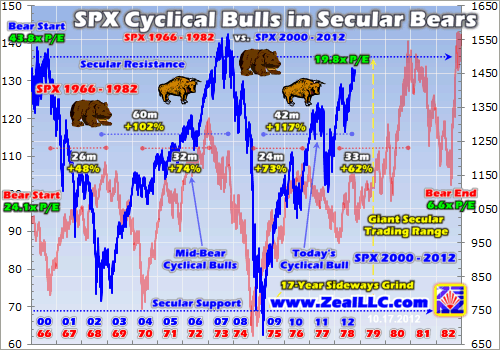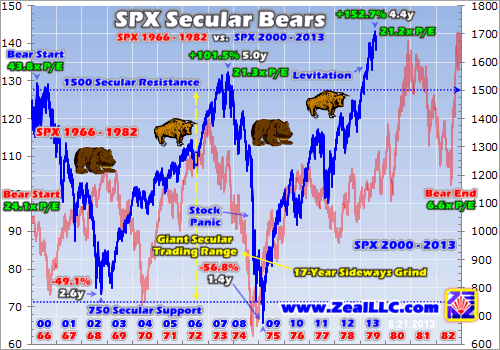Secular bear cyclical bull
Post on: 13 Май, 2015 No Comment

MarkHulbert
ANNANDALE, Va. (MarketWatch) — Secular or cyclical?
I’m referring, of course, to the debate over what kind of bull market began on March 9.
If that day represented a once-in-a-generation stock market low — such as the kind seen in December 1974, for example — then we’re in a secular bull market that can be expected to last for many years and which will eventually take the stock market averages to a final top that is several times current levels.
Or did it mark a mere cyclical low, in which our expectations, both in terms of time as well as price, need to be far more modest?
For guidance I turn to Ned Davis, the eponymous head of institutional research firm Ned Davis Research. In my daily readings of what’s being posted in the investment arena, including emails from the nearly 200 newsletters monitored by the Hulbert Financial Digest, I consistently find Davis’ comments to be among the best-reasoned, based on a cool and unsentimental assessment of hard data.
I disagree with Davis at my peril, such as earlier this year when I — but not he — concluded that the sentiment data did not support a powerful rally.
Now is a particularly good time to check in with Davis, since earlier this week he finished a seven-part series in which he compared the March 9 low with the famous secular lows of decades past. Davis was able to identify seven dimensions that he could use to compare the March 9 low to those past secular lows:
- Monetarily, money should be cheap and amply available: Neutral. You might think that this factor should be rated as bullish, given how accommodative the Federal Reserve is currently. But Davis notes that banks are also significantly tightening their lending standards. Given the heavy load of debt under which both consumers as well as corporations suffer (see next criterion), banks are finding it increasingly hard to find ‘credit-worthy’ borrowers.
- Economically, the debt structure should be deflated. Bearish. This is the most negative of any of Davis’ seven dimensions, since by no means is the debt structure deflated. On the contrary, Davis calculates that the total credit-market debt load right now is nearly four times the size of gross domestic product, and that it takes more than $6 of new debt for our country to produce just $1 of GDP growth. That’s almost double the amount of debt required in the 1990s.
- There should be a large pent-up demand for goods and services. Bearish. Davis acknowledges that there has been improvement along this dimension from where things stood at the beginning of the bear market. But he is particularly worried by the ratio of total Personal Consumption Expenditures to Non-Residential Fixed Investment, which currently stands at a record high. At the secular bear market low in 1982, in contrast, this ratio was at a record low.
- Fundamentally, stocks should be clearly cheap based upon time-tested, absolute valuation measures. Neutral. Though the stock market got undervalued at the March lows, it never became dirt cheap.
- Psychologically, investors should be deeply pessimistic, both in terms of the stock market and the economy. Bullish. Davis says that past secular market lows were accompanied by an extreme amount of pessimism, and his indicators show a similar extreme existed earlier this year.
- Technically, major investor groups should have below-average stock holdings and large cash reserves. Neutral. While foreign investors have record-low stock holdings, according to Davis, household holdings — while low — are not nearly as low as they were at prior secular bear market lows. And institutional investors’ stock holdings are only down to an average weighting historically.
- A fully oversold longer-term market condition in terms of normal trend growth and in terms of time. Neutral. Davis believes that, though many of the excesses of the real-estate bubble have been worked off, some still exist. That’s particularly a problem, he says, given that the stock market bubble of the late 1990s never completely deflated either. As we saw in Japan after 1990, a double-bubble in stocks and real estate leaves it difficult to put ‘humpty dumpty’ together again.

The bottom line? Only one of the seven foundations of a secular bull market is in place. Three more are neutral, and the remaining three are bearish.
Davis therefore concludes that we are more likely to be in a cyclical rather than secular bull market.
This doesn’t have to mean that the stock market will immediately go down from here, by the way. Davis believes that the cyclical bull market that began on March 9 still has more upside potential.
But he doesn’t foresee that upside potential being anything like what existed at past major bear-market lows, such as in December 1974.














